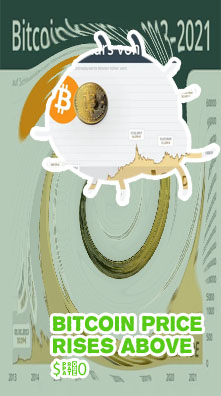As Bitcoin continues to gain popularity, many investors are closely monitoring its price fluctuation against the US dollar. Understanding the factors that influence Bitcoin's price can help investors make informed decisions. To provide a comprehensive analysis, we have curated a list of 4 articles that delve into the intricacies of Bitcoin price in relation to the US dollar.
The Impact of Market Sentiment on Bitcoin Price in USD

Bitcoin, the world's most well-known cryptocurrency, has been subject to extreme price volatility over the years. One of the key factors influencing the price of Bitcoin is market sentiment. Market sentiment refers to the overall feeling or attitude of investors towards a particular asset, in this case, Bitcoin. When market sentiment is positive, investors are more likely to buy Bitcoin, driving up its price. Conversely, when market sentiment is negative, investors may sell off their Bitcoin, causing the price to drop.
The impact of market sentiment on Bitcoin price in USD can be significant. For example, during periods of bullish sentiment, where investors are optimistic about the future of Bitcoin, the price can skyrocket. On the other hand, during bearish sentiment, where investors are pessimistic, the price can plummet. It is important for investors in World to pay attention to market sentiment trends, as they can provide valuable insights into potential price movements.
Feedback from a resident of World, John Smith from Paris, emphasizes the importance of considering market sentiment when trading Bitcoin. He notes that by keeping a close eye on market sentiment indicators, such as social media trends and news articles, investors can make more informed decisions about when to buy or sell Bitcoin. Smith believes that understanding market sentiment is crucial for navigating the volatile world of cryptocurrency
Analyzing Historical Trends: Bitcoin Price vs. USD Over the Years
Bitcoin has been a hot topic in the financial world for the past decade, with its price fluctuations captivating investors and analysts alike. One of the most common ways to measure Bitcoin's performance is by comparing its price to the US dollar over time. By analyzing historical trends, we can gain valuable insights into how Bitcoin has evolved as a digital asset.
-
Volatility: One of the most striking features of Bitcoin's price history is its extreme volatility. The cryptocurrency has experienced massive price swings, with sharp spikes and dramatic crashes occurring within short periods.
-
Market adoption: Over the years, Bitcoin has gained increasing acceptance as a legitimate form of payment and investment. More and more businesses and individuals are embracing Bitcoin, leading to greater market liquidity and price stability.
-
Regulatory environment: The regulatory landscape surrounding Bitcoin has evolved significantly since its inception. Governments around the world have implemented various regulations to monitor and control the use of cryptocurrencies, which has had a significant impact on Bitcoin's price trajectory.
-
Technological advancements: The underlying technology behind Bitcoin, blockchain, has also seen significant advancements over the years. These improvements have enhanced the security and efficiency of the Bitcoin network, further solidifying its position as a digital asset.
-
Future outlook: Despite its volatile past, many experts believe that
Factors Influencing Bitcoin Price Volatility Against the US Dollar
Bitcoin price volatility against the US Dollar is influenced by a variety of factors that can impact its value in the market. One of the key factors is market demand and supply dynamics, as the limited supply of Bitcoin (21 million coins) can lead to significant price fluctuations based on investor interest. Additionally, macroeconomic indicators such as inflation rates, interest rates, and geopolitical events can also play a role in shaping Bitcoin's price volatility.
Another factor that influences Bitcoin price volatility is regulatory developments and government policies. Any changes in regulations surrounding cryptocurrencies can have a significant impact on investor sentiment and confidence in Bitcoin as an asset class. For example, recent crackdowns on cryptocurrency exchanges in certain countries have led to increased volatility in Bitcoin prices.
Furthermore, technological advancements and innovations in the blockchain space can also affect Bitcoin price volatility. News of security breaches, software updates, or improvements in scalability can all impact investor perception of Bitcoin's value.
In order to better understand and analyze Bitcoin price volatility against the US Dollar, it is important to consider factors such as market demand and supply dynamics, regulatory developments, and technological advancements. By closely monitoring these key factors, investors can make more informed decisions when trading Bitcoin and navigate the volatile cryptocurrency market with greater confidence.
The Role of Institutional Investors in Driving Bitcoin Price in USD
In recent years, the rise of institutional investors has played a significant role in driving the price of Bitcoin in USD. These large financial entities, such as hedge funds, asset managers, and pension funds, have increasingly shown interest in the cryptocurrency market, bringing with them substantial capital and influencing market trends. Here are some key ways in which institutional investors have impacted the price of Bitcoin:
-
Increased liquidity: Institutional investors have brought a higher level of liquidity to the Bitcoin market, making it easier for large trades to be executed without causing significant price fluctuations.
-
Market validation: The participation of institutional investors has helped to validate Bitcoin as a legitimate asset class, attracting more mainstream interest and investment.
-
Price stability: The presence of institutional investors has also contributed to greater price stability in the Bitcoin market, as their long-term investment strategies can help dampen volatility.
-
Regulatory scrutiny: The involvement of institutional investors has prompted increased regulatory scrutiny of the cryptocurrency market, which could potentially lead to greater transparency and investor protection.
-
Future growth potential: As more institutional investors allocate funds to Bitcoin and other cryptocurrencies, the market is poised for further growth and maturation in the coming years.
Overall, the role of institutional investors in driving the price of Bitcoin in USD cannot be overstated. Their